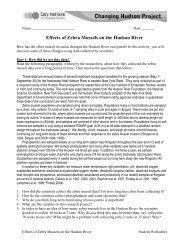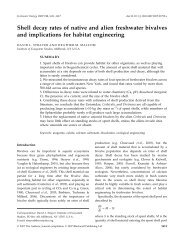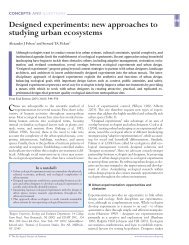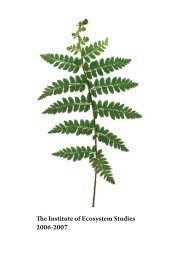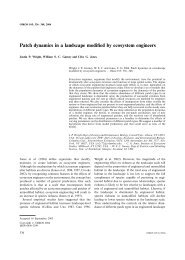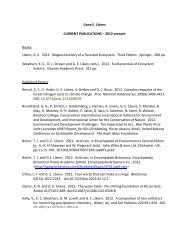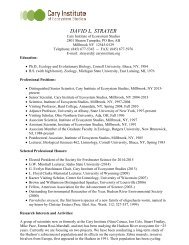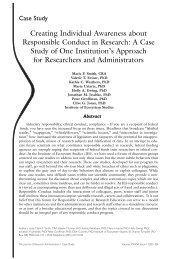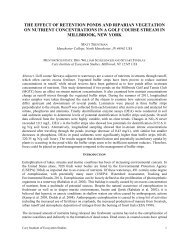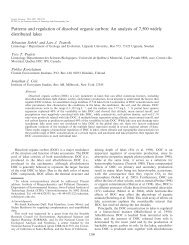Matthew C. Van de Bogert, Stephen R. Carpenter, Jonathan J. Cole ...
Matthew C. Van de Bogert, Stephen R. Carpenter, Jonathan J. Cole ...
Matthew C. Van de Bogert, Stephen R. Carpenter, Jonathan J. Cole ...
You also want an ePaper? Increase the reach of your titles
YUMPU automatically turns print PDFs into web optimized ePapers that Google loves.
<strong>Van</strong> <strong>de</strong> <strong>Bogert</strong> et al.Benthic and pelagic metabolismonly pelagic metabolism, but rather something between thesetwo endpoints. Determining whole-lake metabolism requiresan evaluation of the spatial heterogeneity in one’s study system:How large is the littoral zone—is it 1% or 50% of lakearea? How different are simultaneous metabolism estimatesfrom near shore and at the center of the lake? In larger lakes,are plankton patchy? Questions such as these should beaddressed over a period encompassing a representative rangeof weather patterns (e.g., wind, solar radiation, precipitation),and the answers will help investigators <strong>de</strong>ci<strong>de</strong> whether pursuingmeasurements at higher spatial resolution is necessary oruseful for their particular goals.Although the cost of sensors is dropping, it is still significant.Thus, more work is nee<strong>de</strong>d to <strong>de</strong>termine the minimumnumber nee<strong>de</strong>d for accurate estimates of whole-lake metabolismacross systems. Our data show that on days with highwind speed, measurements are not significantly differentacross sites and therefore the only benefit of many sensors isto verify the uniformity of metabolism estimates. However,on days with low wind speeds, variation among sites may behigh or low and is not predictable with the data we collected.On low wind days, this study shows that for lakes similar toPeter Lake, the number of sensors nee<strong>de</strong>d is >1 and will likelyneed to inclu<strong>de</strong> enough to separately sample the littoral zone,the pelagic zone, and perhaps a few places along the gradientbetween. Although Peter Lake is small, we suspect theseresults will be applicable for many lakes given that 97% of theworld’s lakes are smaller than or equal to the area of PeterLake and that lakes the same size or smaller account for 22%of the worldwi<strong>de</strong> surface area of lakes (Downing et al. 2006).This study <strong>de</strong>monstrates the potential for in-lake heterogeneityto bias single-location estimates of whole-lake metabolismby un<strong>de</strong>restimating benthic contributions. The <strong>de</strong>gree towhich similar bias occurs in larger lakes is a question that stillneeds to be studied.Investigators interested in partitioning benthic and pelagicmetabolism from whole-lake values will need to employ severalsensors (4 to 6 were used in this study) along a littoralpelagicgradient. Although this study did not address the optimalnumber of son<strong>de</strong>s nee<strong>de</strong>d to answer this question, wenote that a minimum of 3 sensor locations is nee<strong>de</strong>d to be ableto simultaneously estimate the two end members of metabolismand the rate of mixing along the transect.The increased use of automated data acquired from sensorsalong with <strong>de</strong>clining cost is leading to enhanced potential tomeasure ecosystem processes. Free-water oxygen measurementslike those used in this study overcome many of thelimitations of bottle and chamber methods, but there is stillmuch to learn about these methods, particularly what types ofsampling regimens are necessary to a<strong>de</strong>quately capture ecosystemestimates of processes like metabolism. Without furtherevaluation of sensor-based methods, process estimates will sufferambiguities similar to traditional techniques. For example,just as traditional 14 C primary productivity methods measuresome unknown value between net and gross primary production(Peterson 1980), a single centrally located oxygen sensormay measure some unknown value between pelagic metabolismand whole-lake metabolism. These ambiguities may bereduced with improved sampling <strong>de</strong>signs coupled with mo<strong>de</strong>lsthat incorporate spatial heterogeneity in ecosystem processes.ReferencesBa<strong>de</strong>, D. L., and J. J. <strong>Cole</strong>. 2006. Impact of chemicallyenhanced diffusion on dissolved inorganic carbon stableisotopes in a fertilized lake. J. Geophys. Res. Oceans 111:C01014. [doi:10.1029/2004JC002684].Caraco, N. F., and J. J. <strong>Cole</strong>. 2002. Contrasting impacts of anative and alien macrophyte on dissolved oxygen in a largeriver. Ecol. Appl. 12:1496-1509.<strong>Carpenter</strong>, S. R., et al. 2005. Ecosystem subsidies: terrestrialsupport of aquatic food webs from C-13 addition to contrastinglakes. Ecology 86:2737-2750.<strong>Carpenter</strong>, S. R., and J. F. Kitchell. 1993. The Trophic Casca<strong>de</strong>in Lakes. London: Cambridge University Press.Chapra, S. C. 1997. Surface Water-Quality Mo<strong>de</strong>ling. New York:McGraw-Hill.Chen, C. C., J. E. Petersen, and W. M. Kemp. 2000. Nutrientuptakein experimental estuarine ecosystems: scaling andpartitioning rates. Mar. Ecol. Prog. Ser. 200:103-116.<strong>Cole</strong>, J. J., N. F. Caraco, G. W. Kling, and T. K. Kratz. 1994.Carbon-dioxi<strong>de</strong> supersaturation in the surface waters oflakes. Science 265:1568-1570.<strong>Cole</strong>, J. J., and M. L. Pace. 1998. Hydrologic variability ofsmall, northern Michigan lakes measured by the additionof tracers. Ecosystems 1:310-320.<strong>Cole</strong>, J. J., M. L. Pace, S. R. <strong>Carpenter</strong>, and J. F. Kitchell. 2000.Persistence of net heterotrophy in lakes during nutrientaddition and food web manipulations. Limnol. Oceanogr.45:1718-1730.Downing, J. A., et al. 2006. The global abundance and size distributionof lakes, ponds, and impoundments. Limnol.Oceanogr. 51:2388-2397.Efron, B., and R. Tibshirani. 1993. An Introduction to theBootstrap. New York: Chapman & Hall.Fee, E. J. 1979. Relation between lake morphometry and primaryproductivity and its use in interpreting whole-lakeeutrophication experiments. Limnol. Oceanogr. 24:401-416.Fellows, C. S., H. M. Valett, and C. N. Dahm. 2001. Wholestreammetabolism in two montane streams: contributionof the hyporheic zone. Limnol. Oceanogr. 46:523-531.Gelda, R. K., and S. W. Effler. 2002. Metabolic rate estimatesfor a eutrophic lake from diel dissolved oxygen signals.Hydrobiologia 485:51-66.Gerhart, D. Z., and G. E. Likens. 1975. Enrichment experimentsfor <strong>de</strong>termining nutrient limitation: 4 methods compared.Limnol. Oceanogr. 20:649-653.Håkanson, L. 2005. The importance of lake morphometry forthe structure and function of lakes. Int. Rev. Hydrobiol. 90:154



